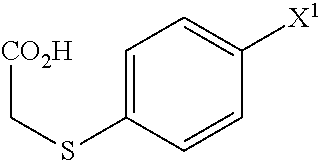Process for production of 1-(3-(2-(1-benzothiophen-5-yl)- ethoxy)propyl)azetidin-3-ol or salts thereof
a technology of azetidin and azetidin, which is applied in the field of new, can solve the problems of low yield, inability to meet the process of (2), and large was
- Summary
- Abstract
- Description
- Claims
- Application Information
AI Technical Summary
Benefits of technology
Problems solved by technology
Method used
Image
Examples
reference example 1
To water (275 mL) suspension of 546 g of thiophenol was dropwise added water (550 mL) solution of 585 g of potassium hydroxide at no more than 20° C. Next, thereto was dropwise added a water (825 mL) solution of 492 g of chloroacetic acid, which was then stirred at 80 to 90° C. for 3 hours. After cooling the reaction mixture, the pH was adjusted to 1.5 with hydrochloric acid, and thereto were added 1650 mL of dichloromethane and 550 mL of water. The organic layer was separated, and anhydrous magnesium sulfate was added. Insoluble matter was filtered off, and to the filtrate was added 5.95 g of iron(III) chloride, and dropwise added 832 g of Bromine at 5 to 10° C., which was then stirred at room temperature for 5 hours. After cooling the reaction solution to 5° C., thereto was dropwise added water (825 mL) solution of 187 g of sodium sulfite, and the pH was adjusted 1.2 with hydrochloric acid. After stirring at 5 to 10° C. for 1 hour, the precipitate was collected by filtration to pr...
reference example 2
To water (600 mL) solution of 88.9 g of sodium hydroxide was added 200 g of 4-bromothiophenol and dropwise added water (300 mL) solution of 105 g of chloroacetic acid, which was then stirred at 60 to 70° C. for 1 hour. After cooling the reaction mixture to 40° C., thereto were added 140 mL of hydrochloric acid and 600 mL of toluene, which was then heated to 80° C. The organic layer was separated and slowly cooled to 5° C. After stirring at the same temperature for 1 hour, the crystals precipitate was collected by filtration to provide 243 g of (4-bromophenylthio)acetic acid as white solid form.
The Chemical shift values of 1H-NMR spectral in CDCl3 agreed with the values of reference example 1.
example 1-1
To dichloromethane (750 mL) suspension of 250 g of (4-bromophenylthio)acetic acid were added 2.5 mL of N,N-dimethylformamide and 132 g of thionyl chloride, which was then refluxed for 1 hour. After cooling the reaction mixture to 20° C., thereto was dropwise added dichloromethane (1500 mL) suspension of 148 g of aluminum chloride at 5 to 15° C., which was then stirred at 15 to 25° C. for 1.5 hours. Next, this reaction mixture was added dropwise to a mixed solution of 1310 mL of water and 188 mL of hydrochloric acid under cooling. The organic layer was separated, thereto was added 1250 mL of water, and the pH was adjusted to 3.0 with 5% potassium carbonate aqueous solution. The organic layer was separated and cooled to 5° C. Thereto were added 15.3 g of sodium borohydride and 500 mL of methanol, which was then stirred at 10 to 20° C. for 2 hours. To the reaction solution was added 750 mL of water, followed by adjustment to pH7.0 using acetic acid and left unattended in room temperatu...
PUM
| Property | Measurement | Unit |
|---|---|---|
| acid | aaaaa | aaaaa |
| protonic acid | aaaaa | aaaaa |
| stability | aaaaa | aaaaa |
Abstract
Description
Claims
Application Information
 Login to View More
Login to View More - R&D
- Intellectual Property
- Life Sciences
- Materials
- Tech Scout
- Unparalleled Data Quality
- Higher Quality Content
- 60% Fewer Hallucinations
Browse by: Latest US Patents, China's latest patents, Technical Efficacy Thesaurus, Application Domain, Technology Topic, Popular Technical Reports.
© 2025 PatSnap. All rights reserved.Legal|Privacy policy|Modern Slavery Act Transparency Statement|Sitemap|About US| Contact US: help@patsnap.com



